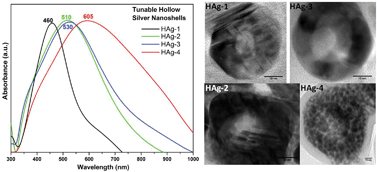Facile tuning of plasmon bands in hollow silver nanoshells using mild reductant and mild stabilizer†
Abstract
Hollow silver

* Corresponding authors
a
Department of Applied Chemistry, Birla Institute of Technology, Mesra, Ranchi-835215, India
E-mail:
amiya.priyam@gmail.com
b Materials Engineering, School of Engineering Sciences and Technology, University of Hyderabad, Hyderabad-500046, India
c Nanoscience and Technology, School of Engineering Sciences and Technology, University of Hyderabad, Hyderabad-500046, India
Hollow silver

 Please wait while we load your content...
Something went wrong. Try again?
Please wait while we load your content...
Something went wrong. Try again?
S. Pattanayak, A. Priyam and P. Paik, Dalton Trans., 2013, 42, 10597 DOI: 10.1039/C3DT50684C
To request permission to reproduce material from this article, please go to the Copyright Clearance Center request page.
If you are an author contributing to an RSC publication, you do not need to request permission provided correct acknowledgement is given.
If you are the author of this article, you do not need to request permission to reproduce figures and diagrams provided correct acknowledgement is given. If you want to reproduce the whole article in a third-party publication (excluding your thesis/dissertation for which permission is not required) please go to the Copyright Clearance Center request page.
Read more about how to correctly acknowledge RSC content.
 Fetching data from CrossRef.
Fetching data from CrossRef.
This may take some time to load.
Loading related content
